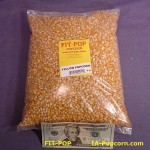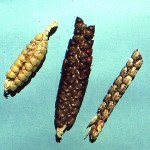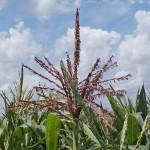What is the truth about GMOs and Popcorn? I’m often asked if FIT-POP contains any genetically modified organisms (GMOs).
The simple answer is no.
 No popcorn seed produced has been genetically modified in a laboratory. It could be done, but not enough popcorn is produced to make it profitable for seed companies to do it. I’ll explain the truth about GMOs and Popcorn better later.
No popcorn seed produced has been genetically modified in a laboratory. It could be done, but not enough popcorn is produced to make it profitable for seed companies to do it. I’ll explain the truth about GMOs and Popcorn better later.
The term “Genetically Modified Organism” sounds scary to many. But it’s just the scientific community trying to impress us with what they have done. But plants have been genetically altered in nature since the beginning of time. Man has been genetically altering plants ever since we started to grow crops. Scientists aren’t putting new “organisms” in the seed. They are just re-arranging material already there.
There are many types of corn grown around the world. A few are sweet corn, Indian corn, flint corn, field corn and popcorn. Field corn and sweet corn are the only varieties of corn that have GMO seed available. So we will just talk about those two.
GMO Origins
 Corn originated in Central America. But then it was very different. Corn is in the warm season grass family. Corn originally grew 3 to 4 feet tall and had 6 or more tiny ears on a stalk. When we started growing corn to eat and feed to livestock we panted it in rows. These rows were usually around 40 inches so horses could walk down them. The farmer naturally saved the seed from the larger ears of corn to plant the next year. The seed from bigger ears tended to produce big ears (and fewer ears on a stalk) both desirable traits. This is when humans first artificially genetically modifying corn.
Corn originated in Central America. But then it was very different. Corn is in the warm season grass family. Corn originally grew 3 to 4 feet tall and had 6 or more tiny ears on a stalk. When we started growing corn to eat and feed to livestock we panted it in rows. These rows were usually around 40 inches so horses could walk down them. The farmer naturally saved the seed from the larger ears of corn to plant the next year. The seed from bigger ears tended to produce big ears (and fewer ears on a stalk) both desirable traits. This is when humans first artificially genetically modifying corn.
What is Detasseling?
 Many of us in the Midwest have had the experience of detasseling field corn. When you detassel corn you are genetically modifying the plant. The pollen in the tassel contains the genes with the genetic makeup of the plant. The pollen falls onto the emerging ear to fertilize each seed. By removing the tassel you are making the plant get pollen from another corn plant. Two varieties of corn then cross to produce a new variety or “hybrid”. It’s a slow process usually taking 5 to 7 years to come up with a successful hybrid. But it was the best system we had until the early 1990’s when scientists “mapped” the genes of the corn plant to discover what each gene was doing in the plant. So now instead of randomly altering the plant genome we can do it one gene at a time, greatly speeding up the process. That is what a genetically modified organism is. We have been doing it for centuries, GMOs are just the next step speeding up the process.
Many of us in the Midwest have had the experience of detasseling field corn. When you detassel corn you are genetically modifying the plant. The pollen in the tassel contains the genes with the genetic makeup of the plant. The pollen falls onto the emerging ear to fertilize each seed. By removing the tassel you are making the plant get pollen from another corn plant. Two varieties of corn then cross to produce a new variety or “hybrid”. It’s a slow process usually taking 5 to 7 years to come up with a successful hybrid. But it was the best system we had until the early 1990’s when scientists “mapped” the genes of the corn plant to discover what each gene was doing in the plant. So now instead of randomly altering the plant genome we can do it one gene at a time, greatly speeding up the process. That is what a genetically modified organism is. We have been doing it for centuries, GMOs are just the next step speeding up the process.
GMO Food Safety
Still not convinced of the safety of GMOs? There is an awful lot of talk saying GMOs aren’t “safe”. But no one say’s why. Fact is GMO crops have been grown commercially for over thirty years. In all that time there has not been even one instance of harm to a human. Now you know the truth about GMOs and popcorn, including GMOs of all other plant based food products.
Summary

But back to popcorn. You go to your grocery store and buy a 2 pound bag of FIT_POP or any brand for that matter. You can rest assured that even though it has been genetically modified. It was not modified in a laboratory. But, you take it home to pop in vegetable oil which is usually soybean oil. About 95% of the soybeans grown in the U.S. have been genetically modified in a laboratory. Been that way for decades. Pretty much all of microwave popcorn uses vegetable oil.
90% of the popcorn grown in the U.S. is consumed in movie theatres. Just about all theatres pop their corn with coconut oil, and as far as I know we don’t have GMO coconuts.
![]() The practice of genetically modifying seed in the laboratory has revolutionized agriculture. But it’s just the next step in an ever evolving agriculture
The practice of genetically modifying seed in the laboratory has revolutionized agriculture. But it’s just the next step in an ever evolving agriculture
